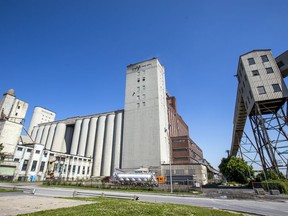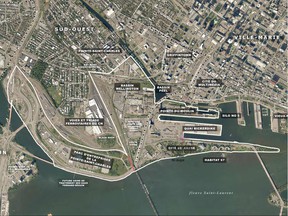Municipal officials were taken aback by claims that the city is dragging its feet and underestimating the housing potential of the sector.

Article content
Three Montreal developers launched a broadside against the Plante administration, saying the city is taking too long to redevelop the Bridge-Bonaventure area and has misjudged its housing potential.
advertisement 2
Article content
With housing emerging as a major issue, Bridge–Bonaventure would be capable of holding at least 12,000 residential units, Serge Goulet, president of developer Devimco Immobilier, told reporters Monday. That’s three times more than what the city projected in a preliminary document shared with developers last month, he said.
Montreal is three years into a consultation process aimed at redeveloping the Bridge-Bonaventure sector, a 2.3-square-kilometre mostly industrial zone that stretches from the western edge of the Old Port to the Champlain Bridge entrance — and would have included a baseball stadium had local investors succeeded in bringing a franchise back to the city. Any new housing planned for the area is unlikely to be ready before 2026, the private developers said Monday.
advertisement 3
Article content

Goulet and executives from real-estate firms Mach Group and Coprim spoke to the media to decry the city’s attitude throughout the consultation process. To show off their vision for the area and hopefully win over public opinion, the developers said they plan to host an “open door” event on May 31 at a still undisclosed location.
“There is a lack of realism” on the part of the city, said Coprim president Vianney Bélanger. “If there’s no change in attitude and a frank and open consultation between all stakeholders, we will end up with a project that we regret.”
Cédric Constantin, vice-president of real estate development at Mach Group, was even more biting.
“As is the case with many projects, the city right now is acting like a dictatorship,” he said. “They are imposing a vision. We developers are taking the risk on these projects, but there is very little ability to listen” on the city’s side, he said.
advertisement 4
Article content
According to Goulet, Montreal should reconsider the way it works with private developers.
“This is probably the most important territory that the city will have ever redeveloped,” he said. “We’ve been trying to be heard for three years. We’ve had to break down the door for them to accept private developers.”
Municipal officials were taken back by the comments.
“What I heard is very much removed from reality,” Robert Beaudry, the executive committee member who looks after urban development, said in an interview with the Montreal Gazette. “I’m quite surprised. We’ve invited the developers to all of the workshops we’ve held” since the consultation process began, he said.
In fact, Beaudry said he and other executive committee members, including Luc Rabouin, held talks with Devimco officials several times over the last few weeks to discuss the project. Just last week, Mach Group’s president met with Mayor Valérie Plante, I added.
advertisement 5
Article content
Bridge-Bonaventure’s industrial area presents planners with a number of logistical challenges. Facilities in the area include those of the Port of Montreal, the ADM mill and several trucking companies. Montreal presented its preliminary vision for the sector in late March — a document that includes plans for about 4,000 housing units and multiple green spaces.
“Because of these major economic activities, whether it’s trucking, frequent train crossings or milling operations, we have to plan for buffer zones,” Beaudry said. “We wouldn’t want property development to harm industrial development, and vice versa. So we need a dialogue. Yes, that takes a certain amount of time, but things are progressing.”
advertisement 6
Article content
Montreal is still “refining its approach” with regards to Bridge-Bonaventure, Beaudry said. The city plans to submit its master plan for the area to the Office de consultation publique de Montréal sometime this fall, I added.
The way Beaudry sees it, developers such as Devimco are too focused on turning a profit by aiming to squeeze as many housing units as possible into the Bridge-Bonaventure area.
“Some parts of the area lend themselves to housing, but others do not,” he said. “If housing units are built too close to industrial activities, there will be no quality of life for the residents. That’s why we need these buffer zones. Our role as an administration is to come up with a global vision that takes into account all of the issues. We cannot endanger quality of life by allowing housing to be built too close to major trucking lines or railroads. There needs to be a balance.”
-
Montreal’s Peel Basin revitalization to proceed even without baseball stadium
-
Developers set sights on ‘forgotten’ Bridge-Bonaventure sector

